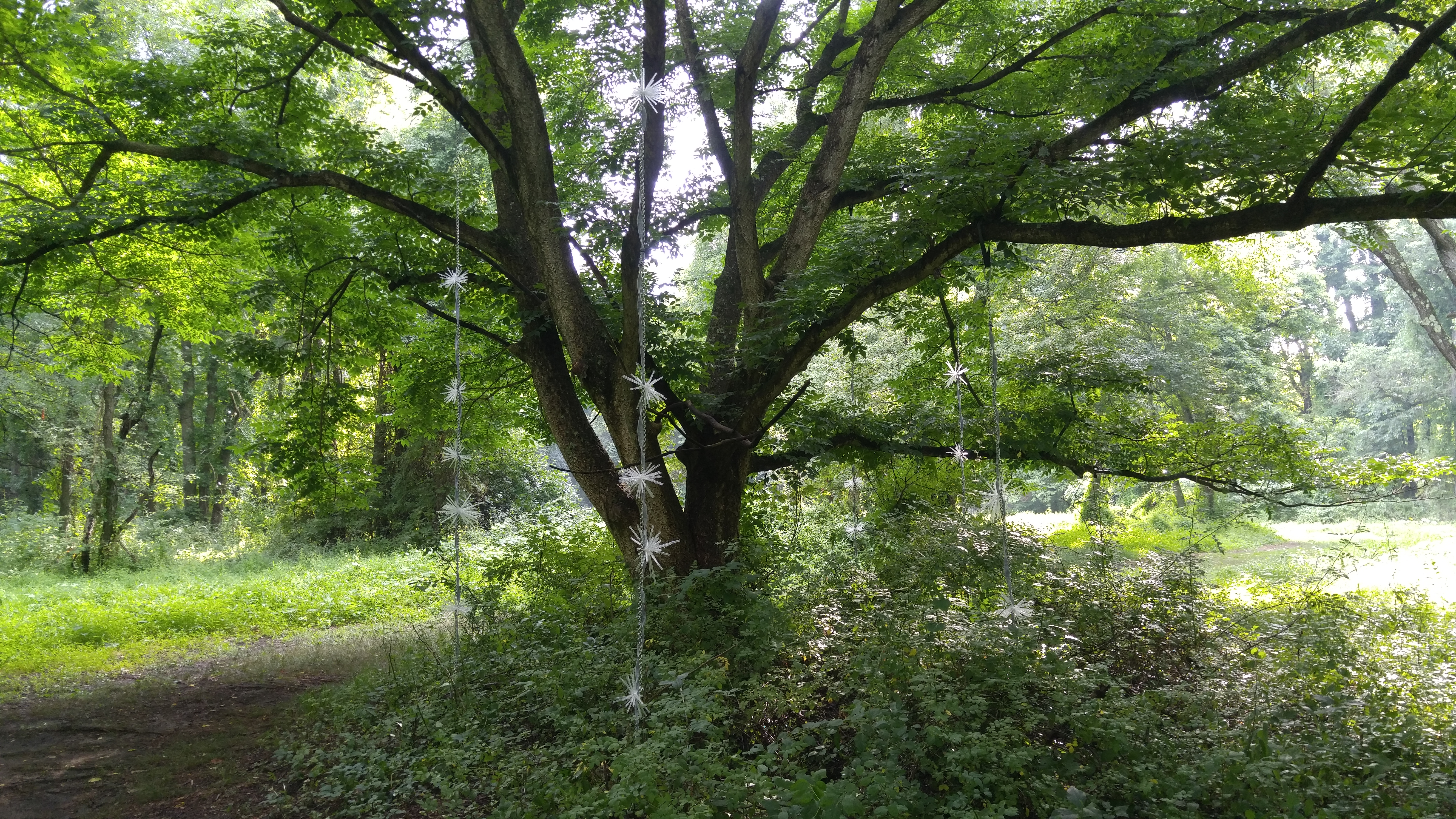by Communications Intern Charlotte Roach

As you wander the trails of the Schuylkill Center, you may notice some objects that look a little out-of-place. What are those chains doing hanging from those tree branches? What are those white geometric shapes on the surface of Wind Dance Pond? Those objects are art installations, part of our LandLab environmental art residency, created by resident artist Kate Farquhar. Kate is a Philadelphia-based environmental artist and landscape architect with a passion for green design. Her series is called Synestates, and its purpose it to explore how human-made building materials can interact with nature.
pvines, located on Pine Grove Loop, is the first of two works Kate has installed so far. The piece is made out of steel chains, intertwined with capillary fabric and sunbursts of plastic straws, draped over the branches of an Amur cork tree. The purpose of pvines is to encourage a native vine, Virginia creeper, to climb up the chains. Capillary fabric has the special property of being able to wick water upwards against gravity. Thus, the fabric provides the vines with a source of water.
In landscape design, rain chains are often used as alternatives to downspouts. Capillary fabric can be used in the building of a plant-covered green wall, which can help insulate a building. Green walls and rain chains are functional, decorative, and artistic, and Kate has brought these materials unexpectedly into nature to help create new habitat. The plastic straws in pvines are arranged in an aesthetically appealing way, and have even become homes for various types of insects like spiders and earwigs.
The second of Kate’s installations is called dolmbale, located on Wind Dance Pond. It is comprised of dense white foam cut into geometric cubes and pyramids. These shapes parallel the molecular structure of nitrogen, phosphorus, and salt. These three substances cause some of the most significant water pollution issues that Pennsylvania faces. An excess of nutrients in the water causes a huge spike in growth for bacteria and algae in a phenomenon known as an algal bloom. The bacteria and algae consume a lot of oxygen, leading to the water becoming depleted of oxygen for other organisms to use. This is known as hypoxia, and it’s lethal for aquatic life. dolmbale’s goal is to raise awareness of nutrient pollution in waterways. Nitrogen, phosphorus, and salt molecules are far, far too tiny to see, but their effects are massive, and clearly visible to the naked eye. Kate’s work imagines if we could see nutrient molecules themselves in a size that’s proportionate to their impact: huge.
To accompany the Styrofoam shapes, Kate collected water quality data on Smith Run (one of two streams on the Schuylkill Center property) as part of a larger citizen science initiative to gather information about water pollution in Pennsylvania. Under smaller versions of her floating cubes, Kate installed leaf packs, which gathered a community of aquatic macroinvertebrates over time. (Aquatic macroinvertebrates = little critters living in the water that you can see unaided, without a microscope). Then, Kate observed, counted, and identified the organisms she caught in the leaf packs. The basis of the method is that some little bugs are more pollution-tolerant than others. For example, leeches can handle just about anything. You may find leeches in filthy, heavily-polluted water, but also in clean water, so the presence of leeches doesn’t definitively indicate clean or dirty water. On the other side of the spectrum, mayflies are delicate little guys, and they need pure, clean water to survive. If you find mayfly larvae in your water, that’s a sure sign the water is relatively free of pollutants. This method is practically universal and can be used to compare pollution levels across regions. It’s not precise, but it’s far more accessible to citizen scientists than expensive machinery. All you need is a body of water, a net, and a key to identify critters.
The data Kate gathered at the Schuylkill Center can be seen here if you zoom into Philadelphia on the interactive map: https://leafpacknetwork.org/data/ Happily, Smith Run received Good or Excellent scores at all three of her sample sites. Check out Stroud Water Research Center’s Leaf Pack Network to learn more about how you can set up your own leaf pack experiment.
Kate’s third Synestates piece, called urlog, will be installed in late summer 2019. urlog will be “a heap of undead wood manipulated to host new seedlings and native pollinators side-by-side”, in Kate’s words. Look forward to seeing urlog in a few weeks, and in the meantime, come observe pvines on Pine Grove Loop and dolmbale on Wind Dance Pond! Ponder the significance of humans and our by-products in the natural world as you enjoy lovely art and scenery. Also, check out this post for some concept art and behind-the-scenes of Synestates as well as some of Kate’s past work, including a spectacular green roof for Urban Outfitters’ Philly HQ!


